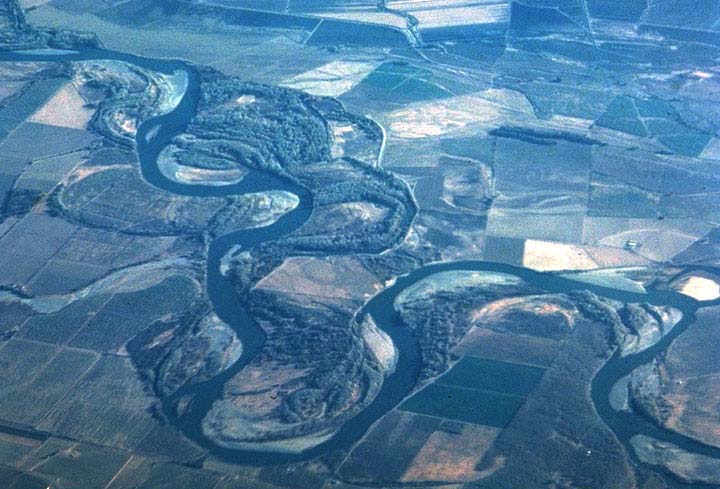Normally it is natural for rivers to run straight. However, there are rivers that flow over gentle sloping ground do begin to curve back and forth. These rivers are called meandering rivers. Meandering rivers are caused by erosion and sediment deposit. In meandering rivers the speed of the flowing water between the two banks differ due to asymmetry or obstruction in the river bed such as rocks, weed growth, or fallen trees. On the faster side of the river less sediment is being deposited and moving water eats into the bank making a small curve. With the water flowing faster more erosion is taking place. On the slower side of the river, more sediment from erosion is deposited. The slower moving water has more time for the soil particles to settle out. So, once the curve is established, the water on the outside must travel faster than on the inside. With this happening the curve becomes more eroded. This is why meandering rivers do not make good political boundaries, because the boundary would be constantly changing. Therefore, the territory would be shifting in the political boundaries. An example of this is the Rio Grande River. This river forms most of the boundary between the United States and Mexico. Flooding during the early 1860’s moved the Rio Grande channel south changing an area of about 2.6 square miles from Ciudad Juarez in Mexico to El Paso in The United States. Both countries then claimed the area which led to the international arbitration of the El Chamizal dispute. This dispute lasted from 1911 to 1963 and was finally put to an end when both countries agreed to sharing the costs of rechanneling the river in an effort to prevent further migrating of its meanders. Since a meandering river can constantly change and with a large flood can shift miles this is why they do not serve as good political boundaries. An area one day could be in your territory and the next not. This would lead to many disputes, frustrations, and high costs.

Hello Diana! You did a great job on your post! It is very detailed and gave me more of a visual of what meandering rivers are as I was reading. It is obvious that meandering rivers are not a reliable border to rely on for political boundaries. Even though it takes time for meandering rivers to form they would not make good political boundaries because they are constantly changing. The example you gave for a meandering river used as political boundaries is a perfect example. Even though it happened a long time ago it is a great example of how using meandering rivers as political boundaries could cause disputes of where a territory is.
LikeLike
Great blog post! I like the way you described the meandering river in such great detail. You also used a great example the Rio Grande River. Meandering rivers can be a cause of conflict just like you described in your post, I am glad both sides came to an agreement and made things better. I agree with you that a meandering river is a poor choice for political boundaries. I am sure with the knowledge we have today we would not choose a meandering to form new boundaries.
LikeLike
Hi Diana. I really enjoyed this post. It was filled with great details, and information. You did a great shop describing meandering rivers in depth. Like you said these rivers form because of erosion and sediment deposits. This causes curves in meandering rivers. They are also constantly changing, which like you said is why they would not make good political boundaries. I love your example because it is the same example I used! I think the Rio Grande is a great example of why meandering rivers should not be used as boundaries. When they change shape the boundary changes too which will always lead to conflict.
LikeLike